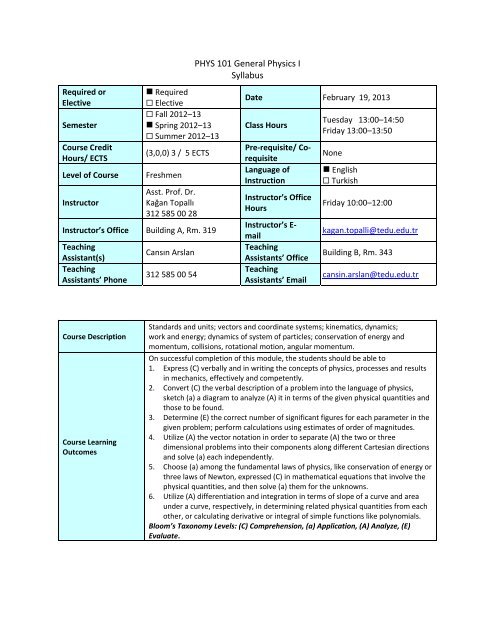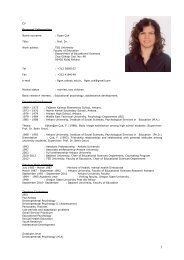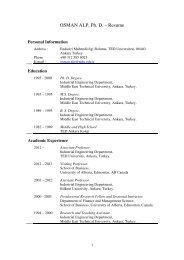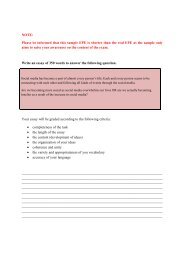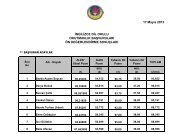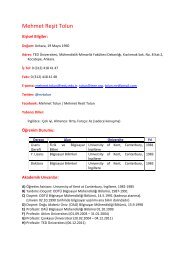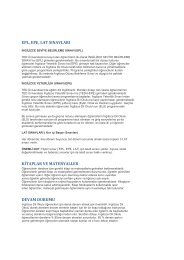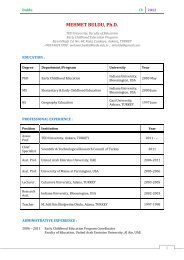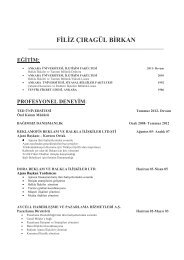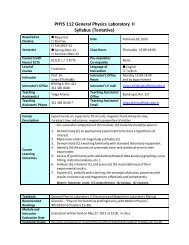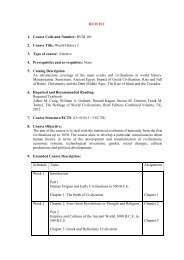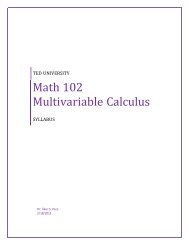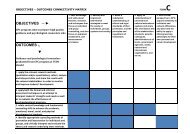PHYS 101 General Physics I Syllabus
PHYS 101 General Physics I Syllabus
PHYS 101 General Physics I Syllabus
Create successful ePaper yourself
Turn your PDF publications into a flip-book with our unique Google optimized e-Paper software.
Required orElectiveSemesterCourse CreditHours/ ECTSLevel of CourseInstructor• Required Elective Fall 2012–13• Spring 2012–13 Summer 2012–13(3,0,0) 3 / 5 ECTSFreshmenAsst. Prof. Dr.Kağan Topallı312 585 00 28Instructor’s Office Building A, Rm. 319TeachingAssistant(s)TeachingAssistants’ PhoneCansın Arslan312 585 00 54<strong>PHYS</strong> <strong>101</strong> <strong>General</strong> <strong>Physics</strong> I<strong>Syllabus</strong>Date February 19, 2013Class HoursPre‐requisite/ CorequisiteLanguage ofInstructionInstructor’s OfficeHoursInstructor’s E‐mailTeachingAssistants’ OfficeTeachingAssistants’ EmailTuesday 13:00–14:50Friday 13:00–13:50None• English TurkishFriday 10:00–12:00kagan.topalli@tedu.edu.trBuilding B, Rm. 343cansin.arslan@tedu.edu.trCourse DescriptionCourse LearningOutcomesStandards and units; vectors and coordinate systems; kinematics, dynamics;work and energy; dynamics of system of particles; conservation of energy andmomentum, collisions, rotational motion, angular momentum.On successful completion of this module, the students should be able to1. Express (C) verbally and in writing the concepts of physics, processes and resultsin mechanics, effectively and competently.2. Convert (C) the verbal description of a problem into the language of physics,sketch (a) a diagram to analyze (A) it in terms of the given physical quantities andthose to be found.3. Determine (E) the correct number of significant figures for each parameter in thegiven problem; perform calculations using estimates of order of magnitudes.4. Utilize (A) the vector notation in order to separate (A) the two or threedimensional problems into their components along different Cartesian directionsand solve (a) each independently.5. Choose (a) among the fundamental laws of physics, like conservation of energy orthree laws of Newton, expressed (C) in mathematical equations that involve thephysical quantities, and then solve (a) them for the unknowns.6. Utilize (A) differentiation and integration in terms of slope of a curve and areaunder a curve, respectively, in determining related physical quantities from eachother, or calculating derivative or integral of simple functions like polynomials.Bloom’s Taxonomy Levels: (C) Comprehension, (a) Application, (A) Analyze, (E)Evaluate.
TextbookRecomendedReadingsModule andInstructorEvaluation DateComputer UsageGiancoli – “<strong>Physics</strong> for Scientists and Engineers, with Modern <strong>Physics</strong>”,4th EditionHalliday, Resnick, and Walker – “Principles of <strong>Physics</strong>”, 9th EditionJewett and Serway – “<strong>Physics</strong> for Scientists and Engineers, with Modern<strong>Physics</strong>”,8th EditionYoung and Friedman –“University <strong>Physics</strong> with Modern <strong>Physics</strong>”, 13thEditionEvaluation will be held on the last day of the class.The Mastering <strong>Physics</strong> (MP) online homework system will be used for gradedhomeworks. In order to do the online home‐works, a student needs to buythe textbook with Student Access Kit from the TEDU Bookstore.(http://www.masteringphysics.com)StudentWorkload(Total 150Hrs)• Lectures ................................ 42 hrs• Course Readings ................... 20 hrs Workshop ................................... hrs Online Discussion ....................... hrs Debate ........................................ hrs Work Placement ......................... hrs Field Trips/Visits ......................... hrs Observation ................................ hrs Lab Applications ......................... hrs Hands‐on Work .......................... hrs• Exams / Quizzes .................... 28 hrs Resource Review ............................ hrs Research Review ............................ hrs Report on a Topic ........................... hrs Case Study Analysis ........................ hrs Oral Presentation ........................... hrs Poster Presentation ........................ hrs Demonstration ................................ hrs Web Designs .................................... hrs Mock Designs .................................. hrs Team Meetings ................................ hrs• Other: Homework ....................... 60 hrsTENTATIVE COURSE OUTLINEW Day Topics ObjectivesIntroduce fundamental quantities of12/19 Measurements (Ch.1) physics and the units that physicists use to Estimatingmeasure them. Differentiate between2/22 Unitsaccuracy and precession in measurements. Dimensional analysisKeep track of significant figures incalculations and conversion of units.2 Kinematics in one dimension2/26(Ch.2)Describe straight‐line motion in terms of Constant acceleration case velocity and acceleration.3/1 Free fallInterpret graphs of position, velocity and
acceleration as functions of time. Solveproblems involving linear motion.34563/53/83/123/153/193/223/263/29 Vectors (Ch.3) Kinematics in two and threedimension Projectile motion, Relativemotion Quiz 1Dynamics (Ch.4)Newton’s three laws of nature Various forces (Ch.5) Circular motion Drag forces, terminal velocity Friction, static and kinetic Quiz 2 Gravitation (Ch.6) Satellites and“Weightlessness” EXAM 1Introduce vectors in Cartesian and polarcoordinates, their addition graphically andalso algebraically in terms of theirCartesian components. Utilize unit vectors.Solve problems for two‐dimensionalmotion by decomposing it into itscomponents.Describe the curved path of a projectile.Introduce the concept of force and relate itto the mass and acceleration of the object.Analyze and utilize Newton’s laws ofmotion using free‐body diagrams.Weight, normal force, contact force.Differentiate between the static andkinetic friction forces. Solve problemsinvolving friction.Introduce centripetal force; relate it to theparticle velocity and radius of the path.Explain why moon does not fall on earth.Relate weight of a body to its mass and itsposition relative to its distance from thecenter of earth.Solve problems related to satellite motion.74/24/5Newton’s synthesisWork and Energy (Ch.7)Scalar products of two vectorsIntroduce scalar product of two vectors.Introduce integration operation.Calculate the amount of work done by aconstant force on a particle.84/94/12Kinetic energyWork–Energy theoremAssociate the total work done on a body tothe change in its kinetic energy.9<strong>101</strong>14/164/19Conservative forces (Ch.8)Potential energyConservation of mechanicalenergy4/234/26Holiday – No class Energy conservation withdissipative forces Quiz 34/30 Linear momentum (Ch.9) Conservation of momentumDifferentiate between the conservativeand non‐conservative forces.Introduce the concept of potential energy.Use the concept of gravitational potentialenergy in vertical motion problems.Use the concept of elastic potential energystored in spring. Examine the conservationof energy with and without dissipativeforces.Introduce the concept of momentum.Examine the conditions under which the
125/3 Impulse EXAM 25/75/10Head‐on collisionsCollisions in two dimensionsElastic and inelastic collisionsCenter of masstotal momentum of a system is constant.Show how the impulse of the net forceacting on a particle changes itsmomentum.Examine collisions in one and twodimensions.Differentiate between elastic and inelasticcollisions.Introduce the concept of center of massfor a system of particles or an extendedbody.Introduce angular quantities and relatethem with their linear analogies. Comparerotational mechanics with that of thelinear case.5/14 Rotational motion (Ch.10) Torque, moment of inertia135/17 Rolling Quiz 4 Angular momentum (Ch.11)5/21 Cross product of vectors14 Conservation of angular5/24momentum15 FINAL EXAMS WEEK, May 25–June 7, 2013Identify the vector nature of angularquantities and relate the rate of change ofangular momentum to torque. Examinethe collision of rotating bodies.COURSE ASSIGNMENTSA. Quiz [5%]There will be 4 quizzes.B. Homework [15%]There will be 6 homework assignments. Some of them will be online and the access to them will beunavailable after their deadlines. In order to do the online home‐works, a student needs to buy thetextbook with Student Access Kit from the TEDU Bookstore.C. Exams [25% + 25%]There will be 2 one‐hour exams: Exam 1 is on 3/29 covering Chapters 1–6;Exam 2 is on 5/3 covering Chapters 7–9.D. Final Exam [30%]There will a cumulative final. Date of the final will be announced at the end of the semester.COURSE ASSESSMENTS & LEARNING OUTCOMES MATRIXAssessment MethodsCourse Learning OutcomesQuizzes 1, 2, 3, 4, 5, 6Homeworks 2, 3, 4, 5, 6Exam 1 1, 2, 3, 4, 5, 6Exam 2 1, 2, 4, 5, 6,Final Exam 1, 2, 3, 4, 5, 6
GRADING SCALEGrade Grade Points Percentage scoresAA 4.00 90 – 100BA 3.50 85 – 89BB 3.00 80 – 84CB 2.50 75 – 79CC 2.00 70 – 74DC 1.50 65 – 69DD 1.00 60 – 64F 0.00 0 – 59FX 0.00 –P – –I. AttendanceCOURSE POLICIES AND SOME REMARKSYou are expected to attend all classes. Classes start on the hour. Please be respectful of your classmates bybeing on time. Cell phones should be turned off and kept out of sight. Please do not use your computers duringclass time.II. Calculator PolicyYou may use a calculator during exams. However, since cell phones will not be allowed in the exam, do notforget to bring your calculator.III. TutoringIn addition to office hours, there will be tutoring hours offered by appointment to get help. If you feel that youneed to sign up for tutoring, please visit Dr. Mana Ece Tuna (Rm. 147, Phone: 585 00 45, e‐mail:mana.tuna@tedu.edu.tr) for necessary arrangements.IV. PlagiarismCollaboration on non‐collected homework and in studying is strongly encouraged; however, the work you handin must be solely your own. Sharing written work before it is turned in to be graded as academic dishonesty. Formore information on TEDU policy on intellectual integrity see the linkhttp://www.tedu.edu.tr/Assets/Documents/News/Public/TEDU_Ogrenci_El_Kitabi_2012.pdf .V. Disability SupportIf you have a disabling condition which may interfere with your ability to successfully complete this module,please contact Dr. Aslı Bugay (e‐mail: asli.bugay@tedu.edu.tr) or Dr. Tolga İnan (e‐mail:tolga.inan@tedu.edu.tr). For more information please see Handbook for Registered Students.VI. Make Up ExamsMake‐up exams for Exam 1 and 2 will not be offered generally. If you have a legitimate reason for missing anexam, then you must arrange to make up the exam before the scheduled time of the exam. The only exceptionsare illness or emergency (e.g., death in family, a traffic accident, etc.). In case of an illness or emergency youneed to supply a documentation that supports your claim.The dates for Make‐up exam for Final are decided by Make‐up Exam Commission according to the rules andregulation of TEDU. Please see the link http://www.tedu.edu.tr/en‐US/Content/Default.aspx?SectionID=114.Also please read the document given in the link http://www.tedu.edu.tr/tr‐TR/Content/Akademik/Akademik_Belgeler/Yonetmelikler_ve_Yonergeler.aspx.


